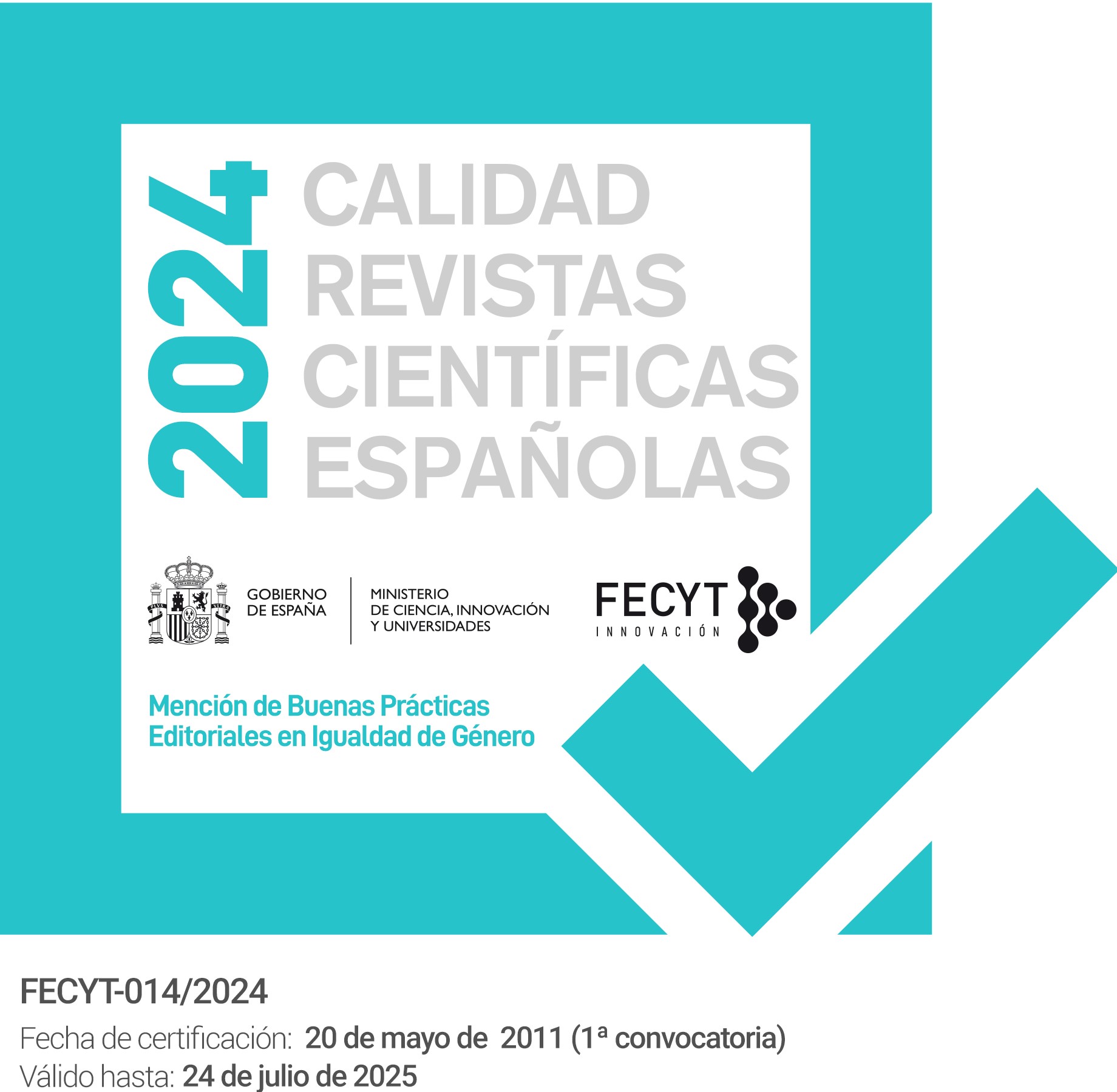Procesos de recepción y efectos socio-cognitivos de películas sobre inmigración. El papel moderador del prejuicio hacia inmigrantes
DOI:
https://doi.org/10.14422/mig.i40.y2016.009Palabras clave:
Películas sobre inmigración, prejuicio, racismo moderno, actitudes hacia la inmigración, persuasión narrativa.Resumen
Se presentan los resultados de una investigación sobre el impacto de películas sobre inmigración en las actitudes hacia dicho colectivo. Se realizó un estudio cuasi-experimental con 142 estudiantes de Bachillerato, estableciéndose dos condiciones: ver una película que enfatizaba la discriminación y suscitaba reacciones de empatía hacia los inmigrantes (Poniente) o ver una película que enfatizaba el contacto intergrupal positivo (El Próximo Oriente). Un mes antes del visionado de las películas se cumplimentó la escala de racismo moderno. Tras el visionado de las películas se midieron la identificación con los personajes del endogrupo y del exogrupo, la actitud hacia la inmigración y otros procesos de recepción relevantes. El visionado de la película diseñada para estimular empatía hacia los inmigrantes provocó mayor identificación con los personajes del exogrupo, lo que a su vez indujo actitudes más positivas hacia la inmigración, pero únicamente cuando el prejuicio previo era bajo o moderado.
Descargas
Citas
ARANA, R. (2007): La inmigración en clave de comedia. Bilbao, Bakeaz.
BATSON, C. D., POLYCARPOU, M. P., HARMON-JONES, E., IMHOFF, H. J., MITCHENER,
E. C., BEDNAR, L. L., KLEIN, T. R. y HIGHBERGER, L. (1997): “Empathy and attitudes: can feelings for a member of a stigmatized group improve feelings toward the group?” Journal of Personality and Social Psychology, 72(1), pp. 105-118.
BAUMERT, A., HOFMANN, W. y BLUM, G. (2008): “Laughing about Hitler? Evaluation of the movie ‘My Fuehrer - The Truly Truest Truth about Adolf Hitler’”. Journal of Media Psychology, 20(2), pp. 43-56.
CAMPBELL, D. y STANLEY, J. (1973): Diseños experimentales y cuasi experimentales en la investigación social. Buenos Aires, Amorrortu.
CASTIELLO, C. (2005): Los parias de la tierra. Inmigrantes en el cine español. Madrid, Talasa.
CEA D’ANCONA, M. A. (2004): La activación de la xenofobia en España. ¿Qué miden las encuestas? Madrid, CIS-Siglo XXI.
COHEN, J. (2001): “Defining identification: a theoretical look at the identification of audiences with media characters”. Mass Communication and Society, 4(3), pp. 245-264.
CONTE, D. (2010): “Espacios discursivos de la inmigración”. En M. IGLESIAS (Ed.), Imágenes del otro. Identidad e inmigración en la literatura y el cine (pp. 33-61). Madrid, Editorial Biblioteca Nueva.
CRISP, R. J. y TURNER, R. N. (2009): “Can imagined interactions produce positive perceptions? Reducing prejudice through simulated social contact”. American Psychologist, 64(4), pp. 231-240.
DAHLSTROM, M. F. (2010): “The role of causality in information acceptance in narratives: an example from science communication”. Communication Research, 37(6), pp. 857-875.
DAL CIN, S., ZANNA, M. P. y FONG, G. T. (2002): “Narrative persuasion and overcoming
resistance”. En E. S. KNOWLES y J. A. LINN (Eds.), Resistance and
persuasion (pp. 175-191). Mahwah, NJ, Lawrence Erlbaum Associates.
DE GRAAF, A., HOEKEN, H., SANDERS, J. y BEENTJES, H. (2012): “Identification as a mechanism of narrative persuasion”. Communication Research, 39(6), pp. 802-823.
DIEKMAN, A. B., McDONALD, M. y GARDNER, W. L. (2000): “Love means never having to be careful: The relationship between reading romance novels and safe sex behavior”. Psychology of Women Quarterly, 24, pp. 179-188.
ENO, C. A. y EWOLDSEN, D. (2010): “The influence of explicitly and implicitly measured prejudice on interpretations of and reactions to black film”. Media Psychology, 13, pp. 1-30.
ESPELT, E. (2009): ¿Somos racistas? Valores solidarios y racismo latente. Barcelona, Icaria.
FINLAY, K. A y STEPHAN, W. G. (2000): “Improving intergroup relations: the effects of empathy on racial attitudes”. Journal of Applied Social Psychology, 30(8), pp. 1720-1737.
GORDILLO, I. (2006): “El diálogo intercultural en el cine español contemporáneo: entre el estereotipo y el etnocentrismo”. Comunicación, 4, pp. 207-222.
GREEN, M. C. y BROCK, T. C. (2000): “The role of transportation in the persuasiveness of public narratives”. Journal of Personality and Social Psychology, 79(5), pp. 701-721.
HAYES, A. F. (2009): “Beyond Baron and Kenny: statistical mediation analysis in the new millennium”. Communication Monographs, 76(4), pp. 408-420.
HAYES, A. F. (2013): Introduction to mediation, moderation and conditional process analysis.A regression-based approach. Nueva York, NY, The Guilford Press.
HAYES, A. F. y MATTHES, M. (2009): “Computational procedures for probing interaction in OLS and logistic regression: SPSS and SAS implementations”. Behavior Research Methods, 41(3), pp. 924-936.
IGARTUA, J. J. (2006): Métodos cuantitativos de investigación en comunicación. Barcelona, Bosch.
— (2007): Persuasión narrativa. Alicante, Editorial Club Universitario.
— (2010): “Identification with characters and narrative persuasion through fictional feature films”. Communications. The European Journal of Communication Research, 35(4), pp. 347-373.
— (2011): “Comunicación mediática, educación para la paz y persuasión narrativa”. En D. PÁEZ, C. MARTÍN BERISTAIN, J. L. GONZÁLEZ-CASTRO, N. BASABE y J. DE RIVERA (Eds.), Superando la violencia colectiva y construyendo cultura de paz (pp. 631-668). Madrid, Fundamentos.
IGARTUA, J. J. y BARRIOS, I. M. (2012): “Changing real-world beliefs with controversial movies. Processes and mechanisms of narrative persuasion”. Journal of Communication, 62(3), pp. 514-531.
IGLESIAS, M. (2010) (Ed.): Imágenes del otro. Identidad e inmigración en la literatura y el cine. Madrid, Editorial Biblioteca Nueva.
MARTÍNEZ-CARAZO, C. (2010): “Inmigración en el cine español. El otro que es siempre el mismo”. En M. IGLESIAS (Ed.), Imágenes del otro. Identidad e inmigración en la literatura y el cine (pp. 185-197). Madrid, Editorial Biblioteca Nueva.
McCONAHAY, J. B., HARDEE, B. B. y BATTS, V. (1981): “Has racism declined in America? It depends upon who is asking and what is asked”. Journal of Conflict Resolution, 25, pp. 563-579.
MOLERO, F. (2007): “El estudio del prejuicio en la psicología social: definición y causas”. En J. F. MORALES, M. C. MOYA, E. GAVIRIA e I. CUADRADO (Coords.), Psicología social (pp. 591-617). Madrid, McGraw-Hill (3ª edición).
MOYER-GUSÉ, E. (2008): “Toward a theory of entertainment persuasion: explaining the persuasive effects of entertainment-education messages”. Communication Theory, 18(3), pp. 407-425.
MOYER-GUSÉ, E. y NABI, R. L. (2010): “Explaining the effects of narrative in an entertainment television program: overcoming resistance to persuasion”. Human Communication Research, 36(1), pp. 26-52.
MOYANO, E. (2005): La memoria escondida. Emigración y cine. Madrid, Tabla Rasa.
MÜLLER, F. (2009): “Entertainment anti-racism. Multicultural television drama, identification and perceptions of ethnic threat”. Communications. European Journal of Communication Research, 34(3), pp. 239-256.
NAVAS, M. S. (1998): “Nuevos instrumentos de medida para el nuevo racismo”. Revista de Psicología Social, 13(2), pp. 233-239.
OLIVER, M. B. y BARTSCH, A. (2010): “Appreciation as audience response. Exploring entertainment gratifications beyond hedonism”. Human Communication Research, 36(1), pp. 53-81.
OLIVER, M. B. y RANEY, A. A. (2011): “Entertainment as pleasurable and meaningful: identifying hedonic and eudaimonic motivations for entertainment consumption”. Journal of Communication, 61, pp. 984-1004.
PÁEZ, D., BOBOWIK, M., CARRERA, P. y BOSCO, S. (2012): “Anexo al capítulo 4. Evaluación de la afectividad durante diferentes episodios emocionales”. En D. PÁEZ, C. MARTÍN BERISTAIN, J. L. GONZÁLEZ-CASTRO, N. BASABE y J. DE RIVERA (Eds.), Superando la violencia colectiva y construyendo cultura de paz (pp. 151-161). Madrid: Fundamentos.
PARK, S. Y. (2012): “Mediated intergroup contact: concept explication, synthesis, and application”. Mass Communication and Society, 15(1), pp. 136-159.
PETTIGREW, T. F. y TROPP, L. R. (2006): “A meta-analytic test of intergroup contact theory”. Journal of Personality and Social Psychology, 90(5), pp. 751-783.
SANTAOLALLA, I. (2005): Los ‘otros’. Etnicidad y raza en el cine español contemporáneo. Zaragoza, Prensas Universitarias.
SCHIAPPA, E., GREGG, P. B. y HEWES, D. E. (2005): “The parasocial contact hypothesis”. Communication Monographs, 72, pp. 92-115.
SHERIF, M. y HOVLAND, C. I. (1961): Social judgment. Assimilation and contrast effects in communications and attitude change. New Haven, CT, Yale University Press.
SLATER, M. D. y ROUNER, D. (2002): “Entertainment-education and elaboration likelihood: understanding the processing of narrative persuasion”. Communication Theory, 12(2), pp. 173-191.
SLATER, M. D. y ROUNER, D. y LONG, M. (2006): “Television dramas and support for controversial public policies: effects and mechanisms”. Journal of Communication, 56(2), pp. 235-252.
TAJFEL, H. (1982): Social identity and intergroup relations. Cambridge, Cambridge University Press.
WRIGHT, S. C., ARON, A., McLAUGHLIN-VOLPE, T. y ROPP, S. A. (1997): “The extended contact effect: knowledge of cross-group friendships and prejudice”. Journal of Personality and Social Psychology, 73(1), pp. 73-90.
ZECCHI, B. (2010): “Veinte años de inmigración en el imaginario fílmico español”. En M. IGLESIAS (Ed.), Imágenes del otro. Identidad e inmigración en la literatura y el cine (pp. 157-184). Madrid, Editorial Biblioteca Nueva.
Descargas
Cómo citar
Número
Sección
Licencia
Los autores de artículos aceptados en la revista Migraciones conservan los derechos de propiedad intelectual sobre sus trabajos y otorgan a la revista los permisos de distribución y comunicación pública de los mismos, consintiendo que se publiquen bajo una licencia Creative Commons NonCommercial-NoDerivatives-Attribution 4.0 International License. Se recomienda a los autores publicar su trabajo en Internet (por ejemplo en páginas institucionales o personales, repositorios, etc.) respetando las condiciones de esta licencia y citando debidamente la fuente original.






